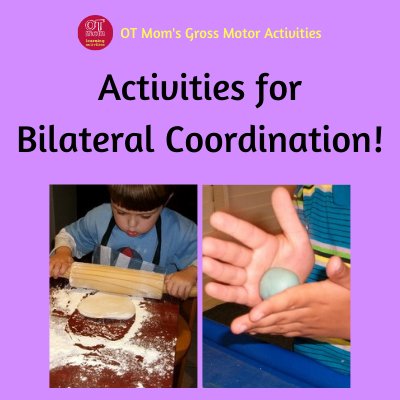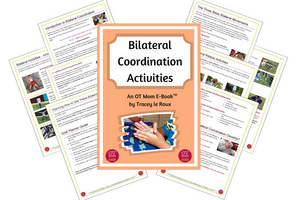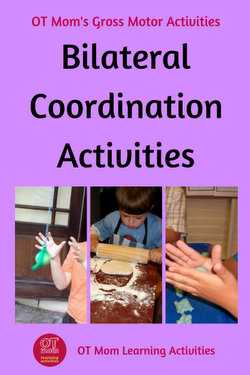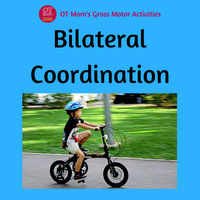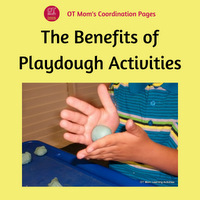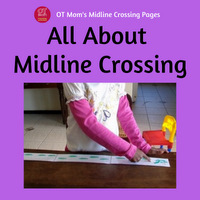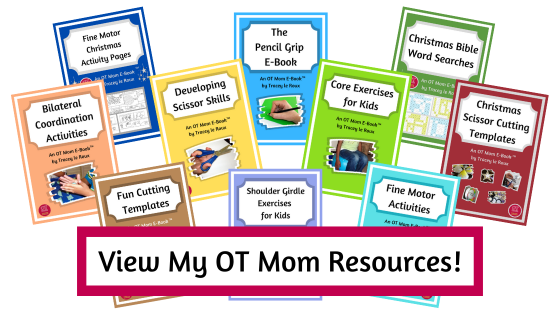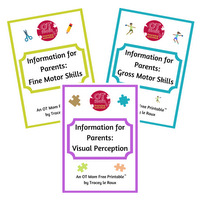- Home Page
- Coordination Skills for Kids
- Bilateral Integration Activities
Bilateral Integration Activities
You can use these simple bilateral integration activities at home to help develop your child's coordination skills!
Studies
have shown that there is a correlation between bilateral coordination
skills and academic performance. Children who were given breaks that
involved bilateral movements were more focused on their academic work
after the break. Math and reading skills have also been linked to good
bilateral integration abilities. (See references)
I sometimes link to products (#Ad) that are similar to those I use and love. If you do purchase something through my links, I will receive a small commission that helps support my site - thank you!
Your child will usually learn to coordinate the use of the arms before the use of the legs, and obviously, the hardest thing is to use the arms and legs together in a coordinated way at the same time (such as jumping jacks). So keep that in mind as you try the following activities!
Most importantly, have fun with your child!
The activities on this page are intended to support your child's normal development. If you are at all concerned about your child's skills, please consult your health professional! The information on this page is not intended to take the place of an occupational therapy evaluation and treatment!
Simple Symmetrical Activities
Rolling out dough with a rolling pin is a lovely, symmetrical bilateral activity.
Get your child involved in rolling out cookie dough, bread dough or playdough!
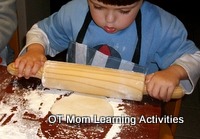 Rolling out dough
Rolling out doughFind some maracas or musical shakers like these ones on Amazon#Ad.
Have your child move them in time to music. Try moving them symmetrically (up and down at the same time) or reciprocally (one hand then the other).
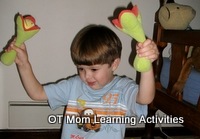 Shaking maracas
Shaking maracasGetting legs to move together is hard work. Start by having your child jump over a line and back again, one jump at a time.
Increase the number of jumps as your child improves at keeping feet together!
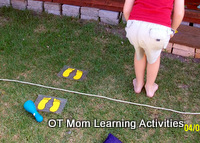 Jumping over a line
Jumping over a lineA Zoom Ball is an awesome toy! Your child needs to open and close the arms symmetrically, to make the ball "zoom" back and forth on the string. One of my favorite bilateral toys!
Amazon usually stock Zoom Balls#Ad - this makes a great toy for outdoors in summer or indoors in winter!
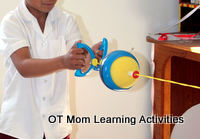 Using a zoom ball
Using a zoom ballSimple Reciprocal Activities
Pulling hand over hand on a rope is a good way to get the hands working rhythmically together.
You can often find these rope ramps at local parks and play centers.
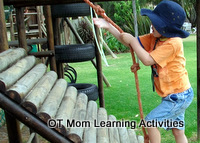 Pulling hand over hand on a rope
Pulling hand over hand on a ropeHave you tried "cooperative" Stretchy Bands like these#Ad?
When a group of kids are making the stretchy band move around in a circle, hand over hand, they are getting a good rhythmical bilateral workout.
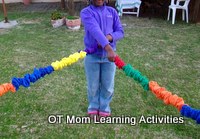 Pulling hand over hand in a circle
Pulling hand over hand in a circleEncourage your child to roll large balls of playdough between two hands to make smooth balls.
Try some of my other playdough ideas to boost bilateral coordination skills.
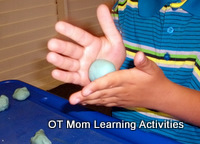 Rolling playdough
Rolling playdoughCreeping (crawling) is another great reciprocal activity - have your child creep across the floor to collect items you put out, or chase them around the floor yourself!
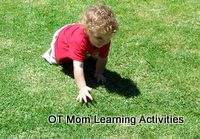 Creeping / Crawling
Creeping / CrawlingIncorporate Lots of Movement!
The vestibular system (which is situated in the inner ear and helps the brain to process movement information) plays a vital role in a child's physical development.
Children who struggle to process movement information from their vestibular systems may also struggle with bilateral integration skills.
For this reason, occupational therapists who use sensory integration techniques may include specific movement activities in their therapy sessions to stimulate the vestibular system before carrying out activities to boost bilateral coordination skills.
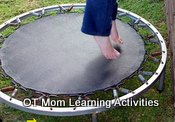 Jumping
Jumping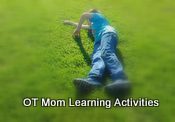 Rolling
RollingAt home, you can give your child's vestibular system a boost by having your child jump on a trampoline, roll on the grass, touch his/her toes, use a swing or do somersaults. You can do these movement activities before or during the bilateral activities.
I have a few ideas for simple vestibular activities you can do in the classroom over here.
Download My E-Book Packed With Bilateral Activities!
If you want to support your child's development of this vital skill, then try my printable download full of Bilateral Coordination Activities!
This 55 page resource contains loads of activities to help your child - with photos and instructions for each activity!
View my Bilateral Coordination E-Book now!
This resource is included in some great bundle deals!
Thanks for visiting!
I hope you found the information to be helpful to you, and that you are inspired by how easy it can be to help your child develop bilateral integration skills!
Looking for more information about Bilateral Integration and what to look out for if your child is struggling? Pop on over and read my Bilateral Coordination page of helpful info.
Why not sign up for my occasional newsletter to keep in touch with new activities and updated pages on my site?
- Home Page
- Coordination Skills for Kids
- Bilateral Integration Activities
Share this page to help others!
Pages Related to Bilateral Integration Activities
Here are some related pages on my site that may help you with more bilateral activity ideas:
References
Buchele Harris, H.; Cortina, K.; Templin, T.; Colabianchi, N. and Chen, W. (2018). Impact of Coordinated-Bilateral Physical Activities on Attention and Concentration in School-Aged Children. BioMed Research International. 2018. 1-7. https://dx.doi.org/10.1155/2018/2539748
Getchell, N. (2006). Age and task-related differences in timing stability, consistency, and natural frequency of children's rhythmic, motor coordination. Developmental Psychobiology. 48. 675-85. https://dx.doi.org/10.1002/dev.20186.
Lane, S.; Mailloux, Z.; Schoen, S.; Bundy, A.; May-Benson, T.; Parham, L.; Roley, S. and Schaaf, R. (2019). Neural Foundations of Ayres Sensory Integration®. Brain Sciences. 9. 153. https://dx.doi.org/10.3390/brainsci9070153.
Mailloux, Z.; Mulligan, S.; Smith Roley, S.; Blanche, E.; Cermak, S.; Coleman, G.G.; Bodison, S.; Lane, C.J. (2011). Verification and Clarification of Patterns of Sensory Integrative Dysfunction. AJOT. Vol.65 (2). https://dx.doi.org/10.5014/ajot.2011.000752
Pacheco, S.; Gabbard, C.; Ries, L. and Bobbio, T. (2016). Relationship Between Interlimb Coordination and Academic Performance In Elementary School Children. Pediatrics International. 58. https://dx.doi.org/10.1111/ped.12972
Wong, T.P.S.; Leung, E.Y.W.; Poon, C.Y.C.; Leung, C.Y.F. and Lau, B.P.H. (2013). Balance performance in children with unilateral and bilateral severe-to-profound-grade hearing impairment. Hong Kong Physiotherapy Journal. 31. 81–87. https://dx.doi.org/10.1016/j.hkpj.2013.07.001
Didn't find what you were looking for? Try a search of my site!
